The summit of the small island is composed of a highly crystalline basalt; lower down I found a hard, stratified slatey sandstone, while on the beach are huge blocks of lava, and scattered masses of white coralline limestone. The larger island has coral rock to a height of three or four hundred feet, while above is lava and basalt. It seems probable, therefore, that this little group of four islands is the fragment of a larger district which was perhaps once connected with Ceram, but which was separated and broken up by the same forces which formed the volcanic cone. When I visited the larger island on another occasion, I saw a considerable tract covered with large forest trees--dead, but still standing. This was a record of the last great earthquake only two years ago, when the sea broke in over this part of the island and so flooded it as to destroy the vegetation on all the lowlands. Almost every year there is an earthquake here, and at intervals of a few years, very severe ones which throw down houses and carry ships out of the harbour bodily into the streets.
Notwithstanding the losses incurred by these terrific visitations, and the small size and isolated position of these little islands, they have been and still are of considerable value to the Dutch Government, as the chief nutmeg-garden in the world. Almost the whole surface is planted with nutmegs, grown under the shade of lofty Kanary trees (Kanarium commune). The light volcanic soil, the shade, and the excessive moisture of these islands, where it rains more or less every month in the year, seem exactly to suit the nutmeg-tree, which requires no manure and scarcely any attention. All the year round flowers and ripe fruit are to be found, and none of those diseases occur which under a forced and unnatural system of cultivation have ruined the nutmeg planters of Singapore and Penang.
Few cultivated plants are more beautiful than nutmeg-trees. They are handsomely shaped and glossy-leaved, growing to the height of twenty or thirty feet, and bearing small yellowish flowers. The fruit is the size and colour of a peach, but rather oval. It is of a tough fleshy consistence, but when ripe splits open, and shows the dark-brown nut within, covered with the crimson mace, and is then a most beautiful object. Within the thin, hard shell of the nut is the seed, which is the nutmeg of commerce. The nuts are eaten by the large pigeons of Banda, which digest the mace, but cast up the nut with its seed uninjured.
The nutmeg trade has hitherto been a strict monopoly of the Dutch Government; but since leaving the country I believe that this monopoly has been partially or wholly discontinued, a proceeding which appears exceedingly injudicious and quite unnecessary.
There are cases in which monopolies are perfectly justifiable, and I believe this to be one of them. A small country like Holland cannot afford to keep distant and expensive colonies at a loss; and having possession of a very small island where a valuable product, not a necessity of life, can be obtained at little cost, it is almost the duty of the state to monopolise it. No injury is done thereby to anyone, but a great benefit is conferred upon the whole population of Holland and its dependencies, since the produce of the state monopolies saves them from the weight of a heavy taxation. Had the Government not kept the nutmeg trade of Banda in its own hands, it is probable that the whole of the islands would long ago have become the property of one or more large capitalists. The monopoly would have been almost the same, since no known spot on the globe can produce nutmegs so cheaply as Banda, but the profits of the monopoly world have gone to a few individuals instead of to the nation.















